Fargo & Moorhead Street Railway

On Thanksgiving Day, November 24, 1904, the Fargo Street Railway accepted its first passenger. The streetcar system had been over 2½ years in the making. The idea was promoted by several Scranton, PA, gentlemen, F.W. Larned and M.E. McDonald. In April, 1902, they submitted a franchise application to the city council. It was approved in June and the Fargo & Moorhead Street Railway Company was incorporated under ND laws in July 1902 with a capitalization of $300,000.
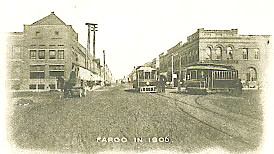
The original promoters ran into financial troubles and their interests inthe street railway system were sold to Fargo businessmen L. B. Hanna, J. W. Smith, W. A. Scott, W. C. McFadden, and others. After surveys were completed and materials received, construction began in May 1904. The system was completed about six months later at a cost of approximately $200,000. (The cost included systems for both Fargo and its neighbor Moorhead, MN.)
The system was completed to an extent that service began on November 25, 1904 with a north side loop, a south side loop, and an Oak Grove line. Fare was 5¢ per person. Service was available from 6 AM to midnight every day except Sunday, when hours were shorter.
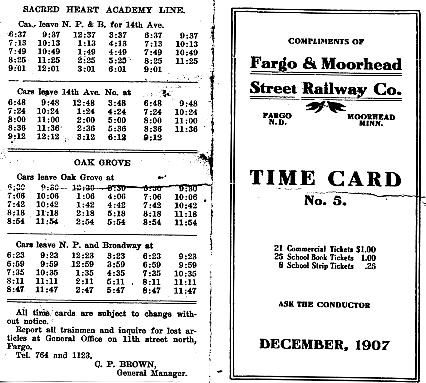
The 1906 postcard on the right above, shows a streetcar turning east onto NP Avenue from Broadway. Note the horse and wagon southbound on Broadway. The postcard on the left shows the street cars and tracks looking north up Broadway. What cannot be seen in the images in the overhead electric wires that followed the tracks and supplied electricity to the cars.
Power for the electric street cars was supplied by the Union Light Heat & Power Company.
The original street carhouse was located at NP Avenue and First Street North. The building taken over by the Fargo Foundry in 1906 when a new car house was built at 216 11th Street North. At that time streetcar offices were moved to 612 NP Avenue.
In 1911, the Fargo and Moorhead Street Railway company was sold to H.M. Byllesby's Consumers Power Company (Consumers was a wholly owned subsidiary of Northern States Power Company, incorporated by Byllesby as a holding company in 1909).
The streetcar line operated continuously until 1937. Service to Moorhead ended on June 30, 1937, and service ended in Fargo on August 21, 1937.
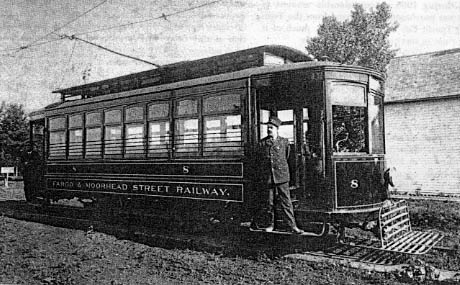
The completed line in Fargo had over seven miles of track, extending from NDAC on the north to Fargo College in the south. Seven cars were available on opening day, and one snow plow. Each car had rattan seats, electric lighting, and was warmed with hot water heaters.
Other types of streetcars can be seen below.

The image above shows a snow plow car pulling a trailer car. The trailer car was used to haul livestock from the downtown trains to the Fairgrounds.
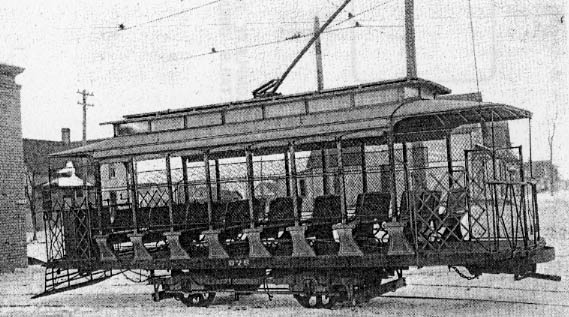
In 1906, several open cars were purchased for use in the summer, as shown above.
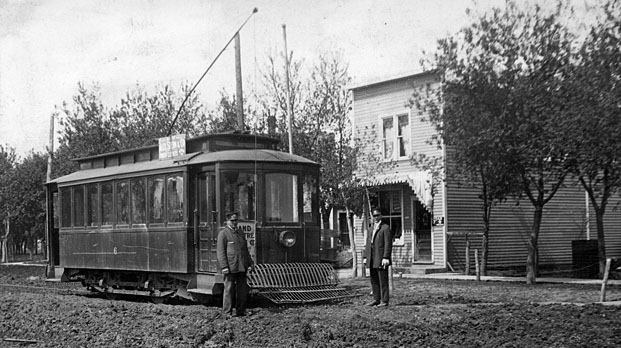
Like today, public transportation was also used for advertising. The sign on top of the streetcar advertises Alex Stern & Co. and the lower sign, obscured by the man on the left, advertises the Grand Theatre.
I am not sure where this picture was taken but the building in the background has a sign that says "STAR" with a star.
